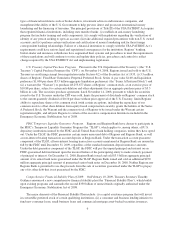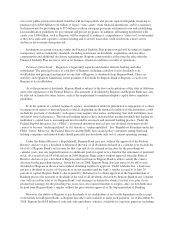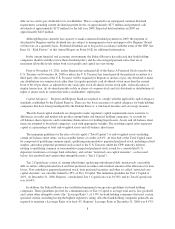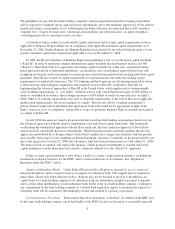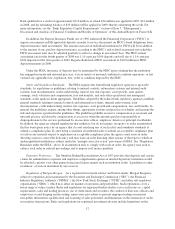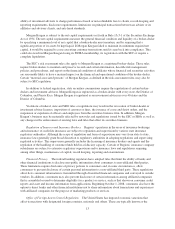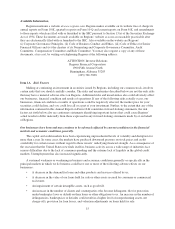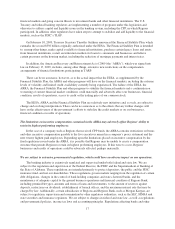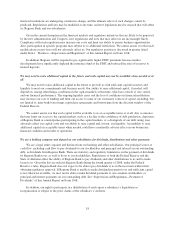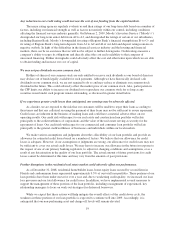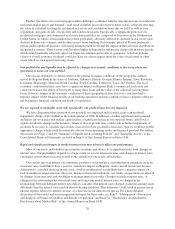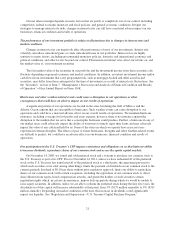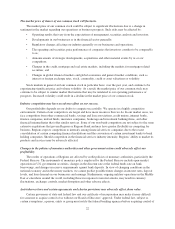Regions Bank 2008 Annual Report Download - page 22
Download and view the complete annual report
Please find page 22 of the 2008 Regions Bank annual report below. You can navigate through the pages in the report by either clicking on the pages listed below, or by using the keyword search tool below to find specific information within the annual report.Bank qualified for a credit of approximately $110 million, of which $34 million was applied in 2007, $41 million
in 2008, and the remaining balance of $35 million will be applied in 2009, thereby exhausting the credit. For
more information, see the “Bank Regulatory Capital Requirements” section of Item 7. “Management’s
Discussion and Analysis of Financial Condition and Results of Operation” of this Annual Report on Form 10-K.
In addition, the Deposit Insurance Funds Act of 1996 authorized the Financing Corporation (“FICO”) to
impose assessments on DIF applicable deposits in order to service the interest on FICO’s bond obligations from
deposit insurance fund assessments. The amount assessed on individual institutions by FICO will be in addition
to the amount, if any, paid for deposit insurance according to the FDIC’s risk-related assessment rate schedules.
FICO assessment rates may be adjusted quarterly to reflect a change in assessment base. The FICO annual
assessment rate for the fourth quarter of 2008 was 1.10 cents per $100 deposits and will rise to 1.14 cents per
$100 deposits for the first quarter of 2009. Regions Bank had a FICO assessment of $10.0 million in FDIC
deposit premiums in 2008.
Under the FDIA, insurance of deposits may be terminated by the FDIC upon a finding that the institution
has engaged in unsafe and unsound practices, is in an unsafe or unsound condition to continue operations, or has
violated any applicable law, regulation, rule, order or condition imposed by the FDIC.
Safety and Soundness Standards. The FDIA requires the federal bank regulatory agencies to prescribe
standards, by regulations or guidelines, relating to internal controls, information systems and internal audit
systems, loan documentation, credit underwriting, interest rate risk exposure, asset growth, asset quality,
earnings, stock valuation and compensation, fees and benefits, and such other operational and managerial
standards as the agencies deem appropriate. Guidelines adopted by the federal bank regulatory agencies establish
general standards relating to internal controls and information systems, internal audit systems, loan
documentation, credit underwriting, interest rate exposure, asset growth and compensation, fees and benefits. In
general, the guidelines require, among other things, appropriate systems and practices to identify and manage the
risk and exposures specified in the guidelines. The guidelines prohibit excessive compensation as an unsafe and
unsound practice and describe compensation as excessive when the amounts paid are unreasonable or
disproportionate to the services performed by an executive officer, employee, director or principal stockholder.
In addition, the agencies adopted regulations that authorize, but do not require, an agency to order an institution
that has been given notice by an agency that it is not satisfying any of such safety and soundness standards to
submit a compliance plan. If, after being so notified, an institution fails to submit an acceptable compliance plan
or fails in any material respect to implement an acceptable compliance plan, the agency must issue an order
directing action to correct the deficiency and may issue an order directing other actions of the types to which an
undercapitalized institution is subject under the “prompt corrective action” provisions of FDIA. See “Regulatory
Remedies under the FDIA” above. If an institution fails to comply with such an order, the agency may seek to
enforce such order in judicial proceedings and to impose civil money penalties.
Depositor Preference. The Omnibus Budget Reconciliation Act of 1993 provides that deposits and certain
claims for administrative expenses and employee compensation against an insured depository institution would
be afforded a priority over other general unsecured claims against such an institution in the “liquidation or other
resolution” of such an institution by any receiver.
Regulation of Morgan Keegan. As a registered investment adviser and broker-dealer, Morgan Keegan is
subject to regulation and examination by the Securities and Exchange Commission (“SEC”), the Financial
Industry Regulatory Authority (“FINRA”), the New York Stock Exchange (“NYSE”) and other self-regulatory
organizations (“SROs”), which may affect its manner of operation and profitability. Such regulations cover a
broad range of subject matter. Rules and regulations for registered broker-dealers cover such issues as: capital
requirements; sales and trading practices; use of client funds and securities; the conduct of directors, officers and
employees; record-keeping and recording; supervisory procedures to prevent improper trading on material
non-public information; qualification and licensing of sales personnel; and limitations on the extension of credit
in securities transactions. Rules and regulations for registered investment advisers include limitations on the
12






